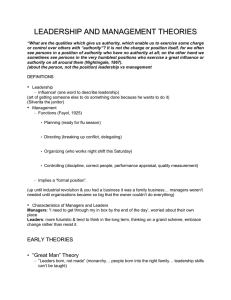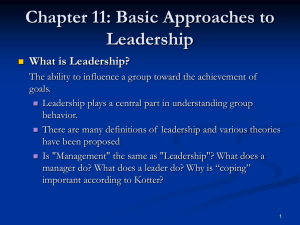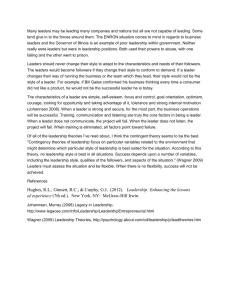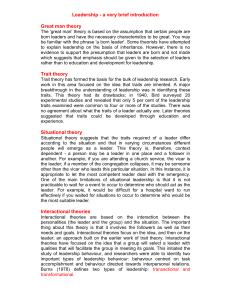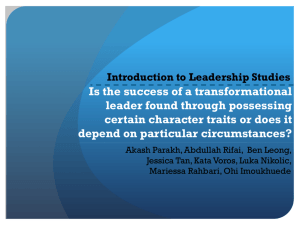Leadership theories and style - EL2014-3O2
advertisement
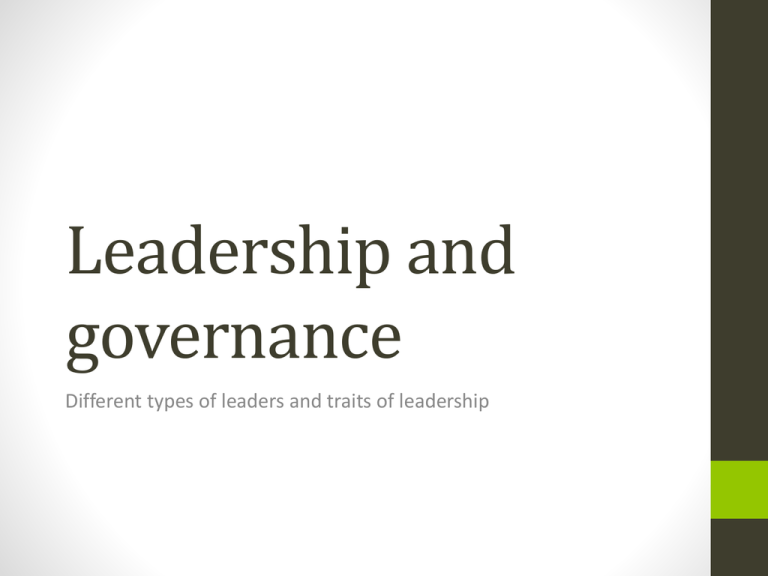
Leadership and governance Different types of leaders and traits of leadership Should PM Lee sue Roy Ngerng? The issues at hand … • What is a good leader? • What are the qualities of a good leader? • How do leaders lead? • Can a good politician be a good leader? • What are the different systems of governance? • Does this have an impact on the leadership style? Leadership • Leadership has been described as "a process of social influence in which one person can enlist the aid and support of others in the accomplishment of a common task". • A leader is simply somebody whom people follow, or as somebody who guides or directs others • Leadership is "organizing a group of people to achieve a common goal" • Peter Drucker famously stated that "management is doing things right; leadership is doing the right things." • Great leaders possess dazzling social intelligence, a zest for change, and above all, vision that allows them to set their sights on the "things" that truly merit attention. Leadership Theories Theories of how leadership works Great Man theory • Great leaders are born, not made • Great leaders are simply born with the necessary internal characteristics such as charisma, confidence, intelligence, and social skills that make them natural-born leaders. • Portray leaders as heroic, mythic and destined to rise to leadership • Notions that in times of need, a Great Man would arise, almost by magic. • Eg: Churchill, Jesus, Moses, Buddha Trait Theory • People are born with inherited traits. • Some traits are particularly suited to leadership. • People who make good leaders have the right (or sufficient) combination of traits. • Underlying assumption that if one could also be found with these traits, then he, too, could also become great leader. Critique • There are plenty of people who possess the personality traits associated with leadership, yet many of these people never seek out or are given positions of leadership. Contingency Theories • The leader's ability to lead is contingent upon various situational factors, including the leader's preferred style, the capabilities and behaviors of followers and also various other situational factors. • There is no one best way of leading and that a leadership style that is effective in some situations may not be successful in others. • Leaders who are very effective at one place and time may become unsuccessful either when transplanted to another situation or when the factors around them change. Situational Theories • Leaders choose the best course of action based upon situational variables. Different styles of leadership may be more appropriate for certain types of decisionmaking. • For example, in a situation where the leader is the most knowledgeable and experienced member of a group, an authoritarian style might be most appropriate. • In other instances where group members are skilled experts, a democratic style would be more effective. • The main difference is that situational theory tends to focus more on the behaviors that the leader should adopt, given situational factors (often about follower behavior), whereas contingency theory takes a broader view that includes contingent factors about leader capability and other variables within the situation. Behavioral Theories • Leaders can be made, rather than are born. • Successful leadership is based in definable, learnable behavior. • According to this theory, people can learn to become leaders through teaching and observation. • This opens the floodgates to leadership development, as opposed to simple psychometric assessment that sorts those with leadership potential from those who will never have the chance. Participative Theories • Ideal leadership style is one that takes the input of others into account. • These leaders encourage participation and contributions from group members and help group members feel more relevant and committed to the decision-making process. • In participative theories, however, the leader retains the right to allow the input of others. Management Theories • Focus on the role of supervision, organization and group performance. • These theories base leadership on a system of rewards and punishments. • Managerial theories are often used in business; when employees are successful, they are rewarded; when they fail, they are reprimanded or punished. Relationship Theories • Focus upon the connections formed between leaders and followers. • Transformational leaders motivate and inspire people by helping group members see the importance and higher good of the task. • These leaders are focused on the performance of group members, but also want each person to fulfill his or her potential. • Leaders with this style often have high ethical and moral standards. Different Leadership styles Charismatic Leader Assumptions • Charm and grace are all that is needed to create followers. • Self-belief is a fundamental need of leaders. • People follow others that they personally admire. Charismatic Leader • The Charismatic Leader gathers followers through dint of personality and charm, rather than any form of external power or authority. • Deliberate charisma is played out in a theatrical sense, where the leader is 'playing to the house' to create a desired effect. They also make effective use of storytelling, including the use of symbolism and metaphor. • Usually to gather a large number of followers – political leaders, religious leaders, cult leaders • Charismatic Leaders who are building a group will often focus strongly on making the group very clear and distinct, separating it from other groups. They will then build the image of the group, in particular in the minds of their followers, as being far superior to all others. • Typically attach themselves firmly to the identify of the group, such that to join the group is to become one with the leader. In doing so, they create an unchallengeable position for themselves. Critique • The values of the Charismatic Leader are highly significant. If they are well-intentioned towards others, they can elevate and transform an entire company. If they are not, they can create cults and effectively cause harm. • Their self-belief is so high, they believe that they are infallible, and hence lead their followers into an abyss • They may also be intolerant of challengers and their irreplaceability (intentional or otherwise) can mean that there are no successors when they leave. Participative Theories Assumptions • People are more committed to actions where they have involved in the relevant decision-making. • People are less competitive and more collaborative when they are working on joint goals. • When people make decisions together, the social commitment to one another is greater and thus increases their commitment to the decision. • Several people deciding together make better decisions than one person alone. Participative Leader • This approach is also known as consultation, empowerment, joint decision-making, democratic leadership, Management By Objective (MBO) and powersharing. • Participative Leadership can be a sham when managers ask for opinions and then ignore them. This is likely to lead to cynicism and feelings of betrayal. Situational Leader • Assumptions : • When a decision is needed, an effective leader does not just fall into a single preferred style • The leaders' perception of the follower and the situation will affect what they do rather than the truth of the situation. The leader's perception of themselves and other factors such as stress and mood will also modify the leaders' behavior. • Leaders not only consider the likelihood of a follower accepting a suggestion, but also the overall importance of getting things done. Transactional Leader Assumptions • People are motivated by reward and punishment. • Social systems work best with a clear chain of command. • When people have agreed to do a job, a part of the deal is that they cede all authority to their manager. • The prime purpose of a subordinate is to do what their manager tells them to do. Transactional leader • Clear structure of what is required of the subordinates and the rewards that will come if they obey • When the Transactional Leader allocates work to a subordinate, they are considered to be fully responsible for it, whether or not they have the resources or capability to carry it out. • When things go wrong, then the subordinate is considered to be personally at fault, and is punished for their failure (just as they are rewarded for succeeding). Critique • The main limitation is the assumption of 'rational man', a person who is largely motivated by money and simple reward, and hence whose behavior is predictable. • But it doesn’t always work this way – Maslow’s hierarchy of needs • When the demand for a skill outstrips the supply, then Transactional Leadership often is insufficient, and other approaches are more effective. Transformational Leader Assumptions • People will follow a person who inspires them. • A person with vision and passion can achieve great things. • The way to get things done is by injecting enthusiasm and energy. Transformational Leader • Transformational Leadership starts with the development of a vision, a view of the future that will excite and convert potential followers • The Transformational Leader thus takes every opportunity and will use whatever works to convince others to climb on board the bandwagon. • Transformational Leaders are always visible and will stand up to be counted rather than hide behind their troops. • Transformational Leaders are often charismatic, but are not as narcissistic as pure Charismatic Leaders, who succeed through a belief in themselves rather than a belief in others. Quiet Leader • Assumptions • The actions of a leader speak louder than his or her words. • People are motivated when you give them credit rather than take it yourself. • Ego and aggression are neither necessary nor constructive. Quiet Leader • Base their success not on ego and force of character but on their thoughts and actions. • The quiet leader leads by example. • They do not tell people what to do. • They do not force people to do things that they are not willing to do. • They do not give loud speeches, sweeping statements and clear cut orders. • They do what needs to be done, inspiring their followers to do the same. Servant Leader • Assumptions • The leader has responsibility for the followers. • Leaders have a responsibility towards society and those who are disadvantaged. • People who want to help others best do this by leading them. Servant Leader • Greenleaf says that true leadership "emerges from those whose primary motivation is a deep desire to help others." • Servant leadership is a very moral position, putting the well-being of the followers before other goals. • The people served grow as individuals, becoming 'healthier, wiser, more autonomous and more likely themselves to become servants' (Greenleaf, 1977). • The extent to which the leadership benefits those who are least advantaged in society (or at least does not disadvantage them). • Name 2 – 3 great leaders (not too ancient please) • What are the qualities they possess that make them great leaders? • What is their leadership style like? • To what extent do leaders pursue personal gains at the expense of morality?


